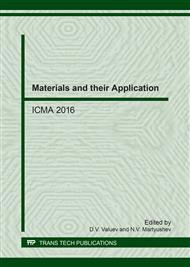[1]
M.S. Ostapenko, D.S. Vasilega, Method of evaluation of quality of metal-cutting tool, J. Applied Mechanics and Materials. 379 (2013) 49-55.
DOI: 10.4028/www.scientific.net/amm.379.49
Google Scholar
[2]
E.V. Artamonov, M.S. Ostapenko, D.S. Vasilega, Improvement of efficiency of modular tooling systems application based on qualimetric evaluation, J. World Applied Sciences Journal. 25 (9) (2013) 1275-1279.
Google Scholar
[3]
M.S. Ostapenko, D.S. Vasilega, An industrial and sociological research of consumers requirements to a lathing tool, J. Key Engineering Materials. 684 (2016) 429-434.
DOI: 10.4028/www.scientific.net/kem.684.429
Google Scholar
[4]
D.S. Vasilega, M.S. Ostapenko, Efficiency improvement of metal lathing by using of an evaluation technique of abembly machine tools quality, J. Key Engineering Materials. 684 (2016) 421-428.
DOI: 10.4028/www.scientific.net/kem.684.421
Google Scholar
[5]
E.V. Artamonov, D.S. Vasilega, M.S. Ostapenko, Methods of considering reliability in the quality evaluation procedure for composite metal cutting tools, J. Applied Mechanics and Materials. 770 (2015) 216-220.
DOI: 10.4028/www.scientific.net/amm.770.216
Google Scholar
[6]
E.V. Artamonov, D.S. Vasilega, A.M. Tveryakov, Determining the maximum-performance temperature of hard-alloy cutting plates, J. Russian Engineering Research. 34 (6) (2014) 402-403.
DOI: 10.3103/s1068798x14060057
Google Scholar
[7]
E.V. Artamonov, D.V. Vasil'ev, Determining the optimal cutting speed in turning by composite cutters on the basis of the chip, Russian Engineering Research. 34 (6) (2014) 404-405.
DOI: 10.3103/s1068798x14060069
Google Scholar
[8]
E.V. Artamonov, D.S. Vasilega, A.M. Tveryakov, Increasing machining efficiency of components made from hard-procebing materials, Applied Mechanics and Materials. 770 (2015) 34-39.
DOI: 10.4028/www.scientific.net/amm.770.34
Google Scholar
[9]
J.L. Chermant, F. Osterstock, Fracture Toughness and Fracture of WC-Co Composites. J. Mat. Sci. №11 (1976) 1939-(1951).
DOI: 10.1007/bf00708272
Google Scholar
[10]
D. Mari, B. Clausen, M.A.M. Bourke, K. Buss, Measurement of residual thermal stress in WC-Co by neutron diffraction , Int. Journal of Refractory Metals and Hard Materials. 27 (2009) 282-287.
DOI: 10.1016/j.ijrmhm.2008.11.015
Google Scholar
[11]
V. Livesu, B. Clausen, J.W. Pagget, A.D. Krawitz, E.F. Drake, M.A.M. Bourke, Measurement and modeling of room temperature co-deformation in WC-10 wt. %Co, Materials Sciense and Engineering. 399 (2005) 134-140.
DOI: 10.1016/j.msea.2005.02.024
Google Scholar
[12]
R.S. Chuykov. S.S. Chuykov, A.A. Mokhovikov, Increase of firmness of the metall-cutting tool on the basis of removal of internal tension in replaceable cutting insert, Applied Mechanics and Materials. 682 (2014) 510-514.
DOI: 10.4028/www.scientific.net/amm.682.510
Google Scholar


